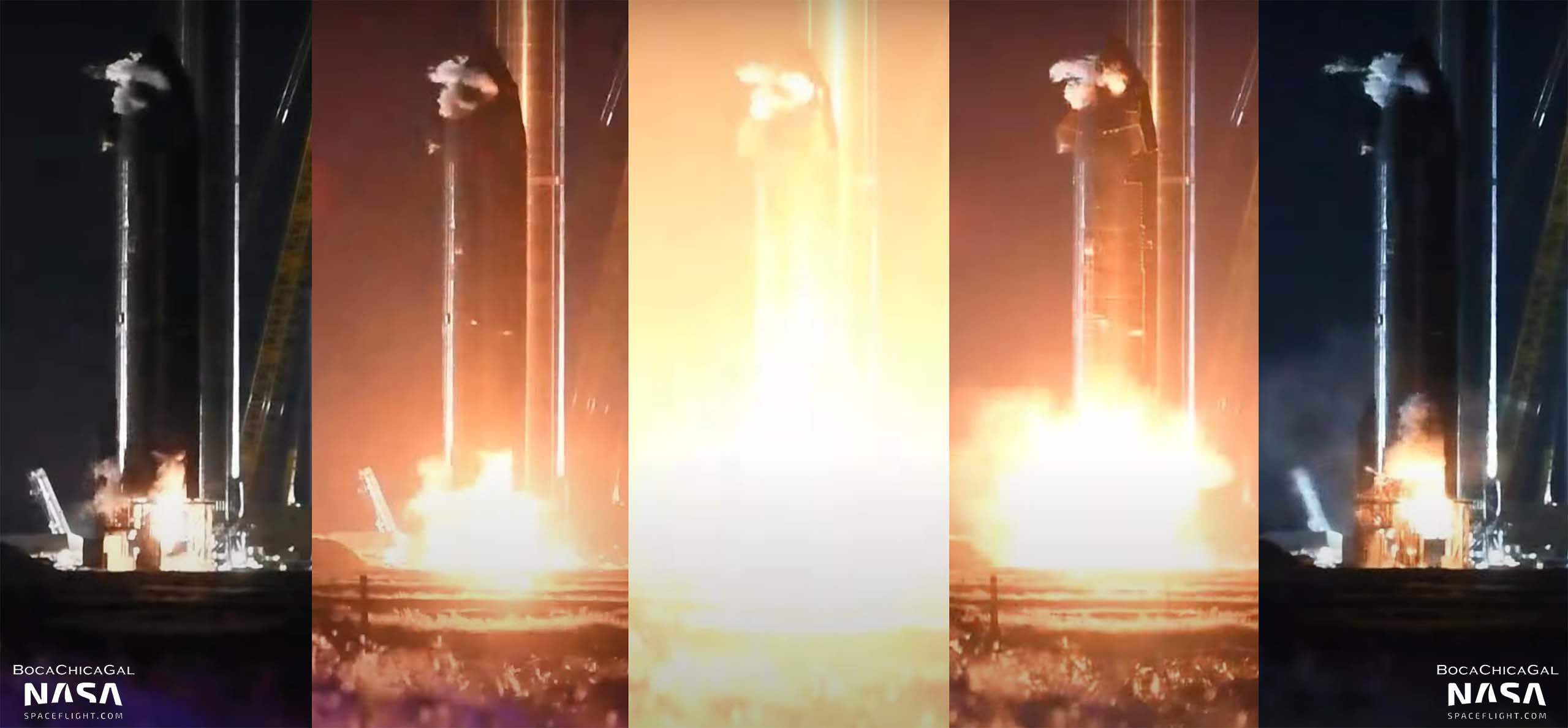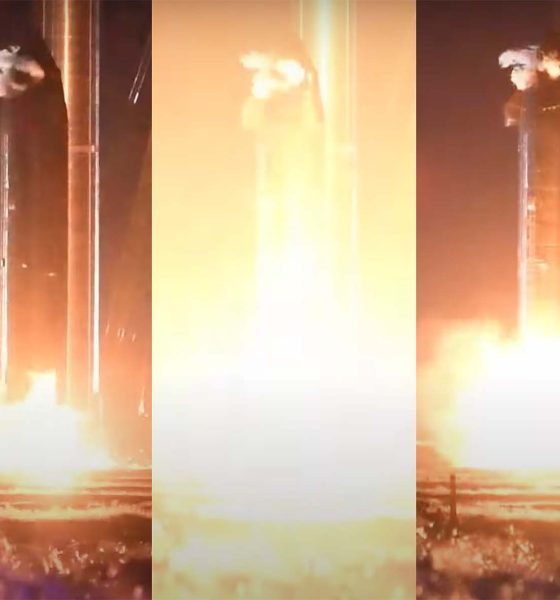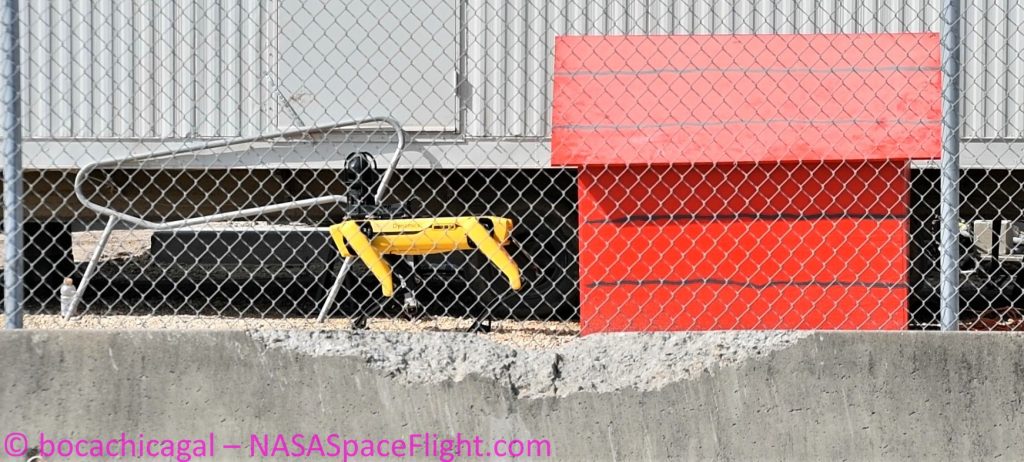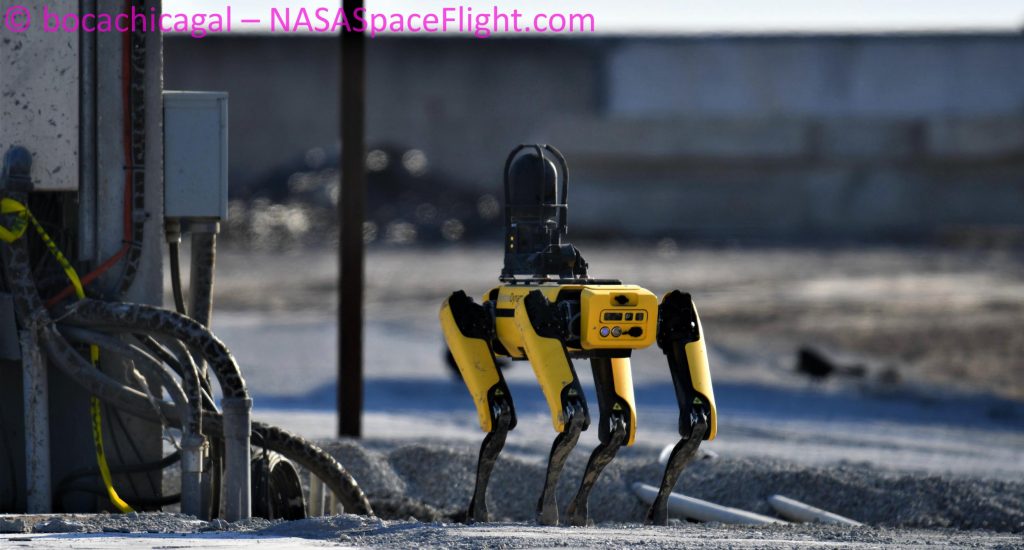

News
SpaceX uses robot dog to inspect Starship after first engine test in months
SpaceX’s first orbital-class Starship prototype has survived the first of several expected Raptor tests, kicking off an engine test campaign that could mark a number of new milestones.
With just 20 minutes left in a seven-hour test window, Starship prototype S20 (Ship 20) appeared to either unsuccessfully attempt its first Raptor static fire test or complete its first intentional Raptor preburner test around 11:40 pm CDT (UTC-5) on Monday, October 18th. Rather than a violent jolt and roar kicking up a cloud of dust, Ship 20 came to life with a (relatively) gentle fireball that lasted for several seconds.
In pursuit of maximum efficiency, Starship’s Raptors require two separate closed-cycle gas generators known as preburners to – as the name suggests – turn its cryogenic (very cold) liquid oxygen and methane propellant into a hot gas mixture that the engine re-ignites to produce thrust. A preburner test, if that’s what Starship S20 completed on Monday night, thus involves activating only the first half of that equation, rapidly producing a giant cloud of flammable gas without actually igniting to produce meaningful thrust.
Preburner tests have become increasingly rare as SpaceX’s sea-level Raptor design matured over the course of tens of thousands of seconds of ground testing and, later, thousands of seconds of ground and flight testing on Starship prototypes. Starship S20 had two engines during its first test. One Raptor was the sea-level optimized variant SpaceX has built dozens of and fired for 30,000+ seconds on the ground. The other, however, was a vacuum-optimized Raptor with a much larger nozzle – the first of its kind to participate in any kind of test while installed on a Starship prototype.
It’s possible that Raptor Vacuum (RVac) engines have even more design tweaks outside of their larger expansion nozzles. Regardless, SpaceX has only built and tested around 10 RVac prototypes over the last year, making it a less mature engine than its sea-level cousins. That could explain why SpaceX appears to have chosen to perform a preburner test first instead of jumping straight into a wet dress rehearsal and static fire. That also means that October 18th’s test was likely the first time a Raptor Vacuum engine has (partially) ignited while installed on a Starship.
The above view from a uniquely situated LabPadre camera all but guarantees that Starship S20’s first engine test was a Raptor Vacuum preburner test and doesn’t offer any strong evidence that it was a two-engine test. Ship 20 still has a number of crucial tests ahead of it before SpaceX can even begin to consider it (or its general design) qualified for flight. That includes multiple static fires, including the first side-by-side static fire of two Raptor variants (RVac and Raptor Center), the first simultaneous static fire of more than three engines, and the first Starship static fire with a full six engines installed.
Ship 20’s preburner test is SpaceX’s first Starbase Raptor test since the first Super Heavy booster static fire in mid-July, almost exactly three months ago.


With any luck, S20’s first preburner test has opened the door for an inaugural static fire of one or both installed engines later this week. However, during that preburner test, the giant fireball Raptor Vacuum emitted appeared to ignite several pieces of pad hardware. SpaceX took advantage of one of at least two Boston Dynamics Spot robots on-site to physically walk a camera up to the active pad and inspect several secondary fires. Ultimately, SpaceX appears to have successfully safed Starship with no damage to the vehicle itself, but odds are good that the sources of those secondary fires will need to be fixed and any pad damage repaired before Ship 20 proceeds into static fire testing. SpaceX has two more 5pm-12am test windows scheduled on October 19th and 20th.

Elon Musk
Elon Musk’s X will start using a Tesla-like software update strategy
The initiative seems designed to accelerate updates to the social media platform, while maintaining maximum transparency.

Elon Musk’s social media platform X will adopt a Tesla-esque approach to software updates for its algorithm.
The initiative seems designed to accelerate updates to the social media platform, while maintaining maximum transparency.
X’s updates to its updates
As per Musk in a post on X, the social media company will be making a new algorithm to determine what organic and advertising posts are recommended to users. These updates would then be repeated every four weeks.
“We will make the new 𝕏 algorithm, including all code used to determine what organic and advertising posts are recommended to users, open source in 7 days. This will be repeated every 4 weeks, with comprehensive developer notes, to help you understand what changed,” Musk wrote in his post.
The initiative somewhat mirrors Tesla’s over-the-air update model, where vehicle software is regularly refined and pushed to users with detailed release notes. This should allow users to better understand the details of X’s every update and foster a healthy feedback loop for the social media platform.
xAI and X
X, formerly Twitter, has been acquired by Elon Musk’s artificial intelligence startup, xAI last year. Since then, xAI has seen a rapid rise in valuation. Following the company’s the company’s upsized $20 billion Series E funding round, estimates now suggest that xAI is worth tens about $230 to $235 billion. That’s several times larger than Tesla when Elon Musk received his controversial 2018 CEO Performance Award.
As per xAI, the Series E funding round attracted a diverse group of investors, including Valor Equity Partners, Stepstone Group, Fidelity Management & Research Company, Qatar Investment Authority, MGX, and Baron Capital Group, among others. Strategic partners NVIDIA and Cisco Investments also continued support for building the world’s largest GPU clusters.
News
Tesla FSD Supervised wins MotorTrend’s Best Driver Assistance Award
The decision marks a notable reversal for the publication from prior years, with judges citing major real-world improvements that pushed Tesla’s latest FSD software ahead of every competing ADAS system.

Tesla’s Full Self-Driving (Supervised) system has been named the best driver-assistance technology on the market, earning top honors at the 2026 MotorTrend Best Tech Awards.
The decision marks a notable reversal for the publication from prior years, with judges citing major real-world improvements that pushed Tesla’s latest FSD software ahead of every competing ADAS system. And it wasn’t even close.
MotorTrend reverses course
MotorTrend awarded Tesla FSD (Supervised) its 2026 Best Tech Driver Assistance title after extensive testing of the latest v14 software. The publication acknowledged that it had previously criticized earlier versions of FSD for erratic behavior and near-miss incidents, ultimately favoring rivals such as GM’s Super Cruise in earlier evaluations.
According to MotorTrend, the newest iteration of FSD resolved many of those shortcomings. Testers said v14 showed far smoother behavior in complex urban scenarios, including unprotected left turns, traffic circles, emergency vehicles, and dense city streets. While the system still requires constant driver supervision, judges concluded that no other advanced driver-assistance system currently matches its breadth of capability.
Unlike rival systems that rely on combinations of cameras, radar, lidar, and mapped highways, Tesla’s FSD operates using a camera-only approach and is capable of driving on city streets, rural roads, and freeways. MotorTrend stated that pure utility, the ability to handle nearly all road types, ultimately separated FSD from competitors like Ford BlueCruise, GM Super Cruise, and BMW’s Highway Assistant.
High cost and high capability
MotorTrend also addressed FSD’s pricing, which remains significantly higher than rival systems. Tesla currently charges $8,000 for a one-time purchase or $99 per month for a subscription, compared with far lower upfront and subscription costs from other automakers. The publication noted that the premium is justified given FSD’s unmatched scope and continuous software evolution.
Safety remained a central focus of the evaluation. While testers reported collision-free operation over thousands of miles, they noted ongoing concerns around FSD’s configurable driving modes, including options that allow aggressive driving and speeds beyond posted limits. MotorTrend emphasized that, like all Level 2 systems, FSD still depends on a fully attentive human driver at all times.
Despite those caveats, the publication concluded that Tesla’s rapid software progress fundamentally reshaped the competitive landscape. For drivers seeking the most capable hands-on driver-assistance system available today, MotorTrend concluded Tesla FSD (Supervised) now stands alone at the top.
News
Elon Musk’s Grokipedia surges to 5.6M articles, almost 79% of English Wikipedia
The explosive growth marks a major milestone for the AI-powered online encyclopedia, which was launched by Elon Musk’s xAI just months ago.

Elon Musk’s Grokipedia has grown to an impressive 5,615,201 articles as of today, closing in on 79% of the English Wikipedia’s current total of 7,119,376 articles.
The explosive growth marks a major milestone for the AI-powered online encyclopedia, which was launched by Elon Musk’s xAI just months ago. Needless to say, it would only be a matter of time before Grokipedia exceeds English Wikipedia in sheer volume.
Grokipedia’s rapid growth
xAI’s vision for Grokipedia emphasizes neutrality, while Grok’s reasoning capabilities allow for fast drafting and fact-checking. When Elon Musk announced the initiative in late September 2025, he noted that Grokipedia would be an improvement to Wikipedia because it would be designed to avoid bias.
At the time, Musk noted that Grokipedia “is a necessary step towards the xAI goal of understanding the Universe.”
Grokipedia was launched in late October, and while xAI was careful to list it only as Version 0.1 at the time, the online encyclopedia immediately earned praise. Wikipedia co-founder Larry Sanger highlighted the project’s innovative approach, noting how it leverages AI to fill knowledge gaps and enable rapid updates. Netizens also observed how Grokipedia tends to present articles in a more objective manner compared to Wikipedia, which is edited by humans.
Elon Musk’s ambitious plans
With 5,615,201 total articles, Grokipedia has now grown to almost 79% of English Wikipedia’s article base. This is incredibly quick, though Grokipedia remains text-only for now. xAI, for its part, has now updated the online encyclopedia’s iteration to v0.2.
Elon Musk has shared bold ideas for Grokipedia, including sending a record of the entire knowledge base to space as part of xAI’s mission to preserve and expand human understanding. At some point, Musk stated that Grokipedia will be renamed to Encyclopedia Galactica, and it will be sent to the cosmos.
“When Grokipedia is good enough (long way to go), we will change the name to Encyclopedia Galactica. It will be an open source distillation of all knowledge, including audio, images and video. Join xAI to help build the sci-fi version of the Library of Alexandria!” Musk wrote, adding in a later post that “Copies will be etched in stone and sent to the Moon, Mars and beyond. This time, it will not be lost.”








